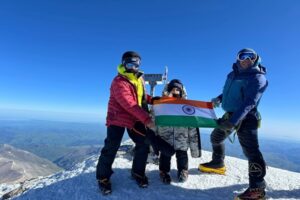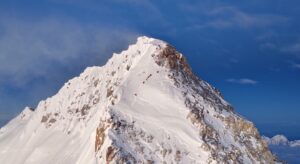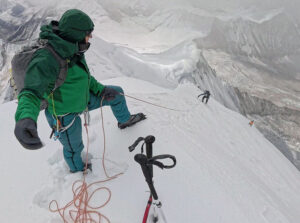It is not surprising that in a normal season, Everest Base Camp contains a higher concentration of millionaires than Monaco’s Rose Ball. It is also not surprising that, despite the familiar mantras that the summit is not as important as the experience, and that the real triumph is returning home safely, the fact is that no one wants to leave without their 8,848m trophy. Especially not after spending what is to most of us a small fortune. On the other hand, there’s a lot more to lose than a summit when playing against a mountain like Everest.
So it’s no wonder that expeditions are not a democracy. The leader leads: He plans, he decides, he has the last word on whether to go up or down. Every client on a guided expedition acknowledges that hierarchy in writing.
As did the four people who joined Garret Madison and a strong Sherpa team for an unusual attempt last year on post-monsoon Everest. Furthermore, they were all aware that they were going to climb a “different” Everest: lonelier, colder, with shorter days and harder progress after the monsoon snows. It was to have been a more challenging yet more adventurous climb of a mountain that, some months earlier, had inspired contempt and negative headlines around the world, after photos showed hundreds of climbers waiting in line at the Hillary Step. Some of those in the queue never made it down alive.

Madison’s Base Camp on a lonely Everest in autumn 2019.
In autumn 2019, however, conditions on Everest were even more dangerous than usual. A huge, unstable serac hung off the West Shoulder, right over the ascent route. Garret Madison judged the risk too high and called the expedition off. All the climbers in Base Camp had to go home without even reaching Camp 1. Perhaps significantly, Madison was also present in 2014, when a similar serac killed 16 Sherpas, including three of his employees.
One year later, the media discovered that one of Madison’s clients, tech company CEO Zachary Bookman, has sued Madison for breach of contract.
The lawsuit has evoked concern on both sides. Outfitters and guides worry that the case could set a precedent, prompting unsafe decisions because of fear of legal retribution. On the other hand, dissatisfied clients may feel that they have no future legal recourse, even if an outfitter’s judgment is at fault.
Currently, Bookman is experiencing a public backlash. Mostly, he is accused of being an inexperienced brat unwilling to accept that an Everest summit cannot be bought. Quotes on the legal document assess the Sherpa crew as “lazy and inefficient” — a description that Bookman now blames on his lawyer. Undermining his fellow clients’ skills has not helped. Finally, although he has been on guided climbs up three of the Seven Summits (Denali, Vinson and Aconcagua), he had never been to the Himalaya before.

The expedition team.
The present case, however, hinges on a guide’s power of decision based on his educated perception of risk, versus a customer’s interests.
To better understand what’s been dubbed the Bookman Everest Affair, ExplorersWeb spoke to the outfitter at the centre of the controversy, Garret Madison.
Let’s talk about the expedition: It was an unusual one, in autumn, with virtually no one else on the mountain. How did you come up with the idea of launching a post-monsoon expedition to Everest?
Well, I had always wanted to try Everest post-monsoon. I’ve been on Cho Oyu, Manaslu and Makalu at that time of year, but never on Everest before. I also had some climbers interested. Finally, four people signed up.
Was it a regular guided trip, or an expedition sponsored by Mountain Hardware? The trademark was in the name of the expedition, so it actually looked like an sponsored trip.
Madison: Correct. Two climbers representing Mountain Hardware (CEO Joe Vernachio and sponsored professional climber Tim Emmett) were trying to get to the summit, and a group of MH employees came on the trek to BC. They were also testing some new equipment, gathering content for their marketing, etc. For them, this was the Mountain Hardware Everest Expedition 2019. There were also two independent climbers who signed up a little later: Zachary Bookman and Kristin Bennett.

Garrett Madison, Kristin Bennett and Zachary Bookman.
Did the non-sponsored climbers feel there was a problem with that?
Madison: None at all.
Did you explain clearly to your clients what an Everest expedition in autumn means, how there are fewer summit options and tougher conditions?
Yes, I told them that Everest post-monsoon is much harder, that nobody had reached the summit of Everest in that season since 2010, and that in general, conditions are more winter-like: more snow, higher winds, colder temperatures. I explained that it would be a bigger challenge but also a different experience than Everest in spring — especially because some climbers now prefer to avoid spring Everest because of that photo that Nims Dai [Nirmal Purja] took of the crowded summit ridge.
Had Mr. Bookman attempted Everest before?
No, it was his first time on Everest, and I don’t believe he had even been on an 8,000’er before.
Aren’t your clients supposed to have any previous 8,000m experience in order to be accepted on an Everest expedition?
Generally, the clients need to have successfully climbed other mountains like Denali, Aconcagua or Vinson, maybe some 6,000’ers in Nepal like Ama Dablam, Island Peak or Lobuche. I do recommend that they should first climb another 8,000’er, such as Manaslu or Cho Oyu, but it’s not a requirement. They do need to have 6,000m experience before joining an Everest expedition.
Logistics are a critical factor, especially on an otherwise empty Everest. Did you have enough crew to fix the route through the Khumbu Icefall and up to the summit?
Yes, we did. We were actually able to fix the Icefall up to Camp 1, although it took longer than expected. But the Icefall was in very bad condition: In fact, the worst state that my Sherpas and I have ever seen. We suspected that the Icefall was more broken up because the monsoon that season was very heavy and lasted a long time. It lingered till September, and was warmer than usual, with rain pouring down even in Base Camp. We think that the rain may have soaked and broken the ice in the Khumbu Icefall. In spring, after the cold of winter, the ice is more solid.

In the Khumbu Icefall.
But you did manage to get to Camp 1, right?
Yes, we found a way through the Icefall and fixed line to Camp 1.
Was the route fixed under the serac, which eventually prompted you to call the expedition off?
We didn’t see the serac until after the Sherpa team finished fixing the ropes to Camp 1. Then we finally had a nice weather day, the clouds cleared and we saw this big serac hanging from the West Shoulder. On the sunny day, we could also see it from Base Camp. Andrzej Bargiel [after skiing down K2, he hoped to repeat the feat on Everest] was also there, and his team had a drone, which they used to get some close photos. This is when we started talking about the serac and whether it would be too dangerous to climb underneath it.
Around this point, two team members called their attempt off, but you stayed and waited for better conditions, didn’t you?
Yes, I remained there. After the two MH members left, I stayed with my other two clients. We waited about one week, hoping the serac would fall down so it was safe enough to resume climbing. During that time, Bargiel’s Polish team decided to leave Base Camp, and we were the only ones there. It was very lonely!
Also, the weather was not good in Base Camp: cloudy, with some rain or snow. One client wanted to climb Ama Dablam, so she left with some of the Sherpas and did eventually summit Ama Dablam on October 11. Mr. Bookman wanted to go home to San Francisco, so he took a helicopter to Kathmandu, and from there, he flew home.
I remained in place one more week, hoping that the serac might fall. If so, I could call back my Ama Dablam client, maybe even catch Bookman in Kathmandu, get them to Base Camp and resume the climb. However, that never happened. Eventually, I decided that it was too late to fix the whole route and acclimatize for a summit push, even if the serac came down, so I called the attempt off altogether.

The threatening serac hanging from the West Shoulder. See also the video of the Icefall at that time. Photo: Bartek Bargiel
So conditions on the mountain prevented you from progressing further. Was that clear enough from the beginning? Did Mr. Bookman see the serac himself and witness the entire process and the reasons to act as you did?
Yes, but I don’t think that he believed the serac was the problem we believed it to be. And there were bitter words from Mr. Bookman already in Base Camp, with threats of a lawsuit or badmouthing if he was not given part of his money back.
Have any of the other 2019 expedition members supported Bookman’s point of view or his lawsuit?
None of them. On the contrary, I received supportive feedback from them, as well as from other Everest guides and colleagues in the climbing industry.
Mr. Bookman has also mentioned that Kilian Jornet was there, and that he actually went under the serac and reached 8,300m on his own, during a fast attempt. His implication was that you could have gone further.
Well, Kilian Jornet is far from an “average” Everest climber. Also, he said that the serac was not so dangerous for him because he could move very quickly underneath it, and he didn’t have any Sherpas to worry about. That is why he and his partner Carlos climbed up to Camp 2: They considered that the risk was justifiable for them alone. But that was not my situation.

Garrett Madison (left) with Kilian Jornet (centre, in black), Zac Bookman between Jornet and his cameraman Carlos and other team members. Photo: Madison Mountaineering
Looking back, if you had known in advance that the Khumbu Icefall was in such a poor state, would you have gone ahead with the expedition?
No, I would have reconsidered the whole thing.
Would you go again to Everest in fall?
Yes, I would still like to try it myself in future, but I will not bring clients at that time. I think that despite our attempts to inform them, their expectations were that there isn’t such a big difference between fall and spring, when conditions are better in every way.
I thought if this had worked, this might have become an alternative to a spring expedition. But after what happened, I am reluctant to try something like that again.
What is the state of the lawsuit now?
Madison: The judge dismissed the case in California, but Bookman may decide to start the process again in Washington State, which is the proper jurisdiction. I do not know if he wants to continue, because his chances of winning are small to none.
MORE:
Madison Mountaineering’s expedition recap
ExWeb interview with Garrett madison Prior to fall 2019 Everest expedition






